Intel's Core 2 Extreme & Core 2 Duo: The Empire Strikes Back
by Anand Lal Shimpi on July 14, 2006 12:00 AM EST- Posted in
- CPUs
Application Performance using SYSMark 2004 SE
We'll kick off our look at general application performance with SYSMark 2004 SE and as always, and we'll look at the overall score as well as the scores in each of the two suites - Internet Content Creation and Office productivity.
As we saw in our last preview of Intel's Core 2 Extreme processor, it posted SYSMark scores that were well beyond anything either AMD or Intel had been able to deliver in the past. With the final version of Core 2 silicon in our hands and a more stable/tweaked platform, we got even better numbers out of Conroe:
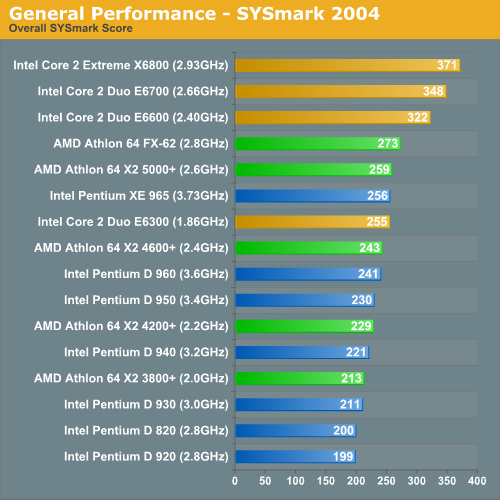
At the high end, the Core 2 Extreme X6800 was just under 36% faster than the Athlon 64 FX-62. In fact, even the $316 E6600 was around 18% faster than AMD's fastest. To add even more insult to injury the slowest Core 2 Duo in the test, the 1.86GHz E6300 is barely slower than AMD's fastest Athlon 64 X2.
The old Intel lineup of Pentium D processors is truly an embarrassment. Only the Extreme Edition 965 is remotely competitive and even then it can barely outperform the $183 E6300.
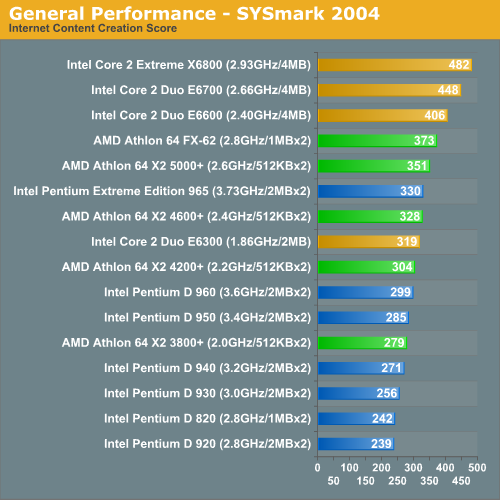
Drilling down into the SYSMark scores we've got the overall ICC results, which honestly are not much different than the overall scores we saw above. The Core 2 Extreme X6800 holds a 29% performance advantage over the FX-62 and once again, and the E6600 is able to outperform AMD's best by over 8%.
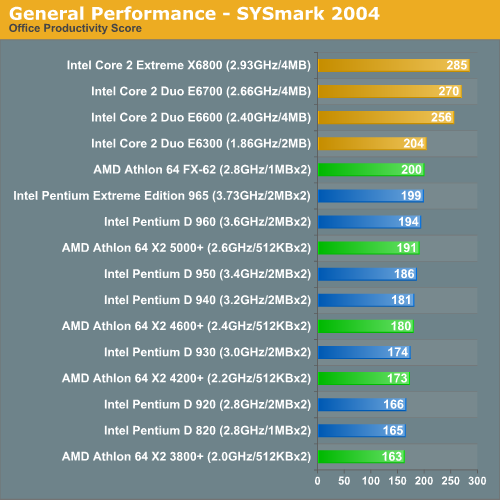
Intel's Core 2 performance domination continues in the Office Productivity portion of SYSMark 2004, with the Core 2 Extreme X6800 maintaining a 42.5% performance advantage over the FX-62. This time around, even the E6300 manages to remain competitive with the FX-62. This is Intel's new $183 part offering performance equal to that of AMD's $1,000 flagship FX processor; it's going to take a lot for AMD to recover from this deficit.
The individual SYSMark 2004 SE scores are graphed below if you're interested. The data is used in calculating the overall scores we've already discussed above:
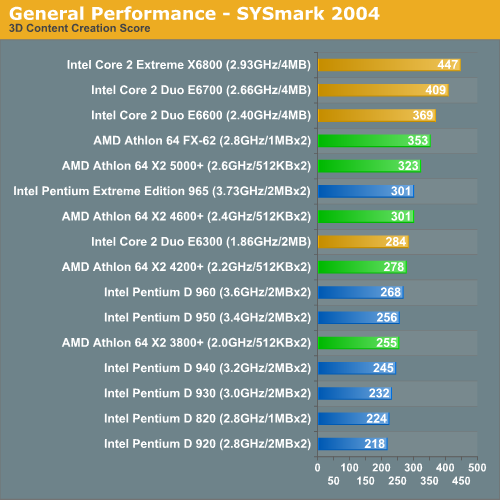
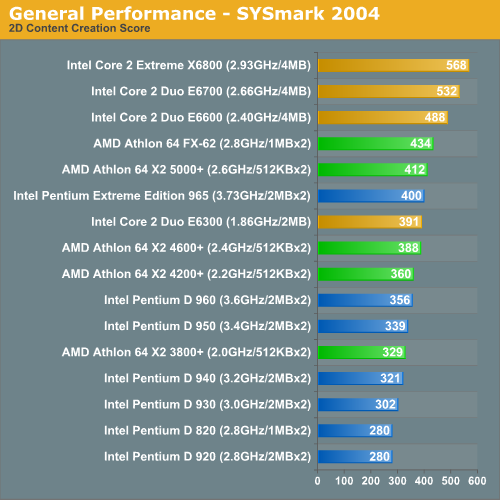
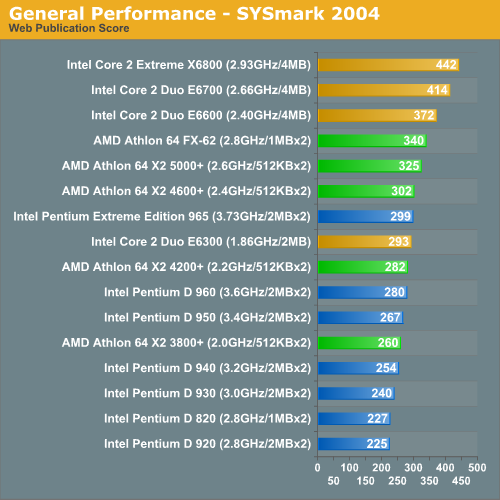
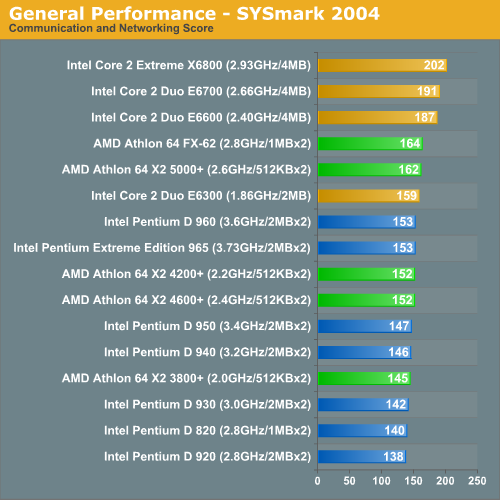
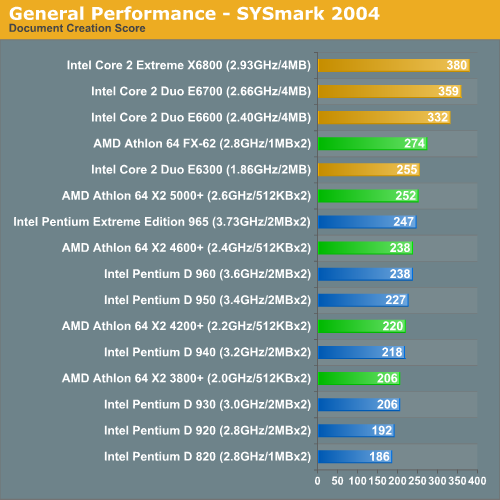
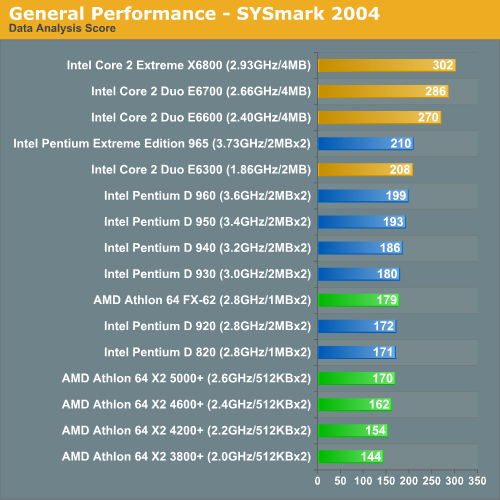










202 Comments
View All Comments
coldpower27 - Friday, July 14, 2006 - link
Are there supposed to be there as they aren't functioning in Firefox 1.5.0.4coldpower27 - Friday, July 14, 2006 - link
You guys fixed it awesome.Orbs - Friday, July 14, 2006 - link
On "The Test" page (I think page 2), you write:please look back at the following articles:
But then there are no links to the articles.
Anyway, Anand, great report! Very detailed with tons of benchmarks using a very interesting gaming configuration, and this review was the second one I read (so it was up pretty quickly). Thanks for not saccrificing quality just to get it online first, and again, great article.
Makes me want a Conroe!
Calin - Friday, July 14, 2006 - link
Great article, and thanks for a well done job. Conroe is everything Intel marketing machine shown it to be.stepz - Friday, July 14, 2006 - link
The Core 2 doesn't have smaller emoty latency than K8. You're seeing the new advanced prefetcher in action. But don't just believe me, check with the SM2.0 author.Anand Lal Shimpi - Friday, July 14, 2006 - link
That's what Intel's explanation implied as well, when they are working well the prefetchers remove the need for an on-die memory controller so long as you have an unsaturated FSB. Inevitably there will be cases where AMD is still faster (from a pure latency perspective), but it's tough to say how frequently that will happen.Take care,
Anand
stepz - Friday, July 14, 2006 - link
Excuse me. You state "Intel's Core 2 processors now offer even quicker memory access than AMD's Athlon 64 X2, without resorting to an on-die memory controller.". That is COMPLETELY wrong and misleading. (see: http://www.aceshardware.com/forums/read_post.jsp?i...">http://www.aceshardware.com/forums/read_post.jsp?i... )It would be really nice from journalistic integrity point of view and all that, if you posted a correction or atleast silently changed the article to not be spreading incorrect information.
Oh... and you really should have smelt something fishy when a memory controller suddenly halves its latency by changing the requestor.
stepz - Friday, July 14, 2006 - link
To clarify. Yes the prefetching and espescially the speculative memory op reordering does wonders for realworld performance. But then let the real-world performance results speak for themselves. But please don't use broken synthetic tests. The advancements help to hide latency from applications that do real work. They don't reduce the actual latency of memory ops that that test was supposed to test. Given that the prefetcher figures out the access pattern of the latency test, the test is utterly meaningless in any context. The test doesn't do anything close to realworld, so if its main purpose is broken, it is utterly useless.JarredWalton - Friday, July 14, 2006 - link
Modified comments from a similar thread further down:Given that the prefetcher figures out the access pattern of the latency test, the test is utterly meaningless in any context."
That's only true if the prefetcher can't figure out access patterns for all other applications as well, and from the results I'm pretty sure it can. You have to remember, even with the memory latency of approximately 35 ns, that delay means the CPU now has about 100 cycles to go and find other stuff to do. At an instruction fetch rate of 4 instructions per cycle, that's a lot of untapped power. So, while it waits on main memory access one, it can be scanning the next accesses that are likely to take place and start queuing them up and priming the RAM. The net result is that you may never actually be able to measure latency higher than 35-40 ns or whatever.
The way I think of it is this: pipeline issues aside, a large portion of what allowed Athlon 64 to outperform NetBurst was reduced memory latency. Remember, Pentium 4 was easily able to outperform Athlon XP in the majority of benchmarks -- it just did so at higher clock speeds. (Don't *even* try to tell me that the Athlon XP 3200+ was as fast as a Pentium 4 3.2 GHz! LOL. The Athlon 64 3200+ on the other hand....) AMD boosted performance by about 25% by adding an integrated memory controller. Now Intel is faster at similar clock speeds, and although the 4-wide architectural design helps, not to mention 4MB shared L2, they almost certainly wouldn't be able to improve performance without improving memory latency -- not just in theory, but in actual practice. Looking at the benchmarks, I have to think that our memory latency scores are generally representative of what applications see.
If you have to engineer a synthetic application specifically to fool the advanced prefetcher and op reordering, what's the point? To demonstrate a "worst case" scenario that doesn't actually occur in practical use? In the end, memory latency is only one part of CPU/platform design. The Athlon FX-62 is 61.6% faster than the Pentium XE 965 in terms of latency, but that doesn't translate into a real world performance difference of anywhere near 60%. The X6800 is 19.3% faster in memory latency tests, and it comes out 10-35% faster in real world benchmarks, so again there's not an exact correlation. Latency is important to look at, but so is memory bandwidth and the rest of the architecture.
The proof is in the pudding, and right now the Core 2 pudding tastes very good. Nice design, Intel.
coldpower27 - Friday, July 14, 2006 - link
But why are you posting the Manchester core's die size?What about the Socket AM2 Windsor 2x512KB model which has a die size of 183mm2?